ON1 vs. Luminar Neo:Which Photo Editor is the Right Investment?
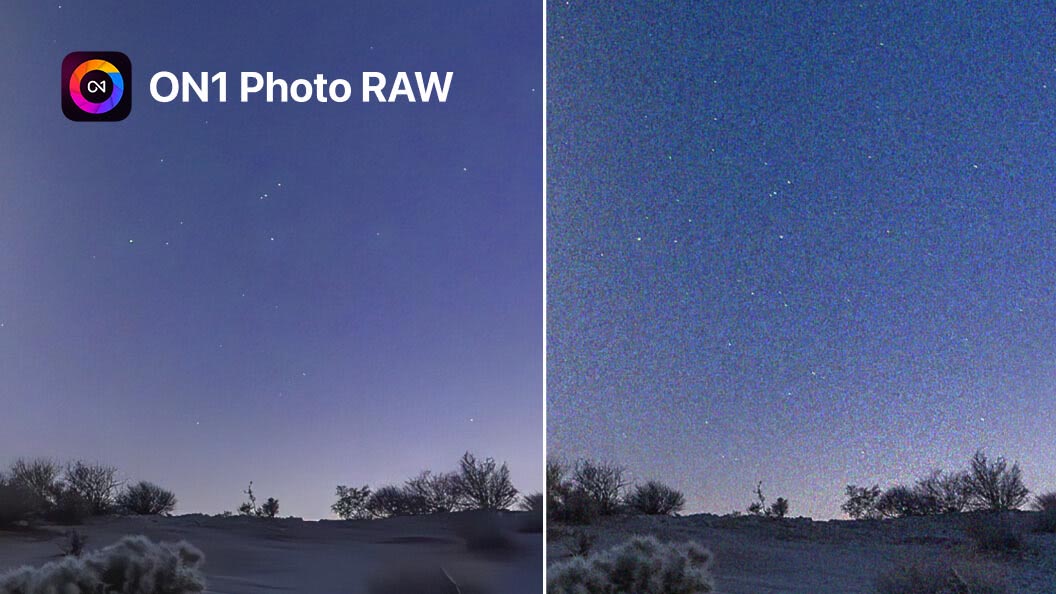
If you've spent any time searching for Lightroom and Photoshop alternatives, you've probably stumbled across two names: ON1 Photo RAW and Skylum's Luminar Neo. Both promise to take the pain out of editing with AI-driven tools, pro-level RAW processing, and, perhaps most appealingly, no Adobe subscription. Here's the thing: while Luminar Neo vs. ON1 may sound like a straight apples-to-apples matchup, the two programs are built on fundamentally different philosophies.
Which should you actually invest in? That depends on you. Here's a clear, side-by-side comparison guide of ON1 vs. Luminar Neo, focusing on pricing, workflow, AI features, image quality, and overall value to help. By the end, you'll know exactly which fits your editing style and your budget.
At-a-Glance: ON1 Photo RAW vs. Luminar Neo
Before we get into the nitty-gritty, here's a quick side-by-side look at ON1 vs. Luminar Neo; the high-level stuff that matters when you're choosing your next editor.
| Pricing Model | One-time purchase ($99.99) or MAX ($199.99) with full plugin suite, or affordable subscription options. | Expensive perpetual license ($417-546) with just 1 year of AI tool access. Upsells for full functionality. |
| Core Strength | All-in-one editing suite (Develop, Effects, Layers, DAM, AI) | Style-heavy, one-click AI effects for fast edits |
| AI Features | Brilliance AI, Super Select AI, NoNoise AI, Resize AI, Portrait AI, Generative Erase/Crop | Enhance AI, GenErase, GenSwap, Supersharp AI, Portrait Bokeh AI |
| Digital Asset Management (DAM) | Full cataloging system with metadata, keywords, ratings, and color labels | Minimal file browser, no cataloging or keywording |
| Layering & Masking | True Photoshop-style layers and masking with AI selections | Limited stacking and basic masking only |
| Ideal User | Enthusiasts and pros needing control, scalability, and Adobe-level flexibility | Creators wanting quick, dramatic edits without deep manual adjustments |
Want to see what a full-featured workflow looks like? Download ON1 Photo RAW free today and take it for a spin.
See the All-New ON1 Photo RAW 2026.2
Want to see how ON1 Photo RAW feels in action? Watch this quick overview to get a feel for the interface, tools, and workflow. If you're ready to get into more advanced techniques, we've got plenty more videos that break down ON1's most powerful features one by one.
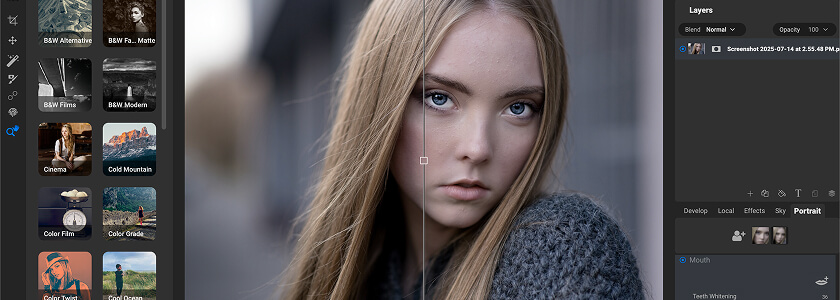
User Interface & Workflow: Speed, Control, and Where Each Shines
When you stack up Luminar Neo and ON1, the biggest difference shows up the second you open them: they're built for two very different kinds of editing brains.
ON1 Photo RAW: Built Like a Pro's Playground
ON1 Photo RAW feels instantly familiar if you've ever touched Lightroom or Photoshop. You get a clear module-based workflow—Browse, Develop, Effects, Resize, Layers—with all your sliders, masks, and local adjustments right where you expect them.
It's a "workhorse" interface: easy enough to navigate but deep enough that you can lose yourself fine-tuning color curves, stacking effects, or building composite layers. Plus, ON1's non-destructive workflow and optional catalogs mean you can manage thousands of images without bogging down your machine.
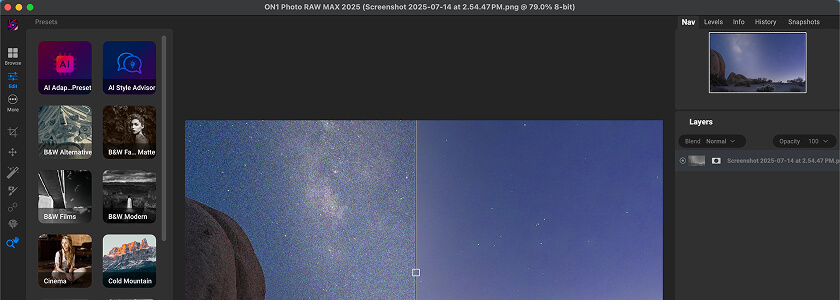
Luminar Neo: Minimalist and Made for Speed
Luminar Neo, on the other hand, is made for speed and simplicity. It leans into one-click AI magic and preset-driven editing. That's great if you just want to make an image pop fast, but you'll feel those limits quickly. There's also no real cataloging system, just a basic file browser, so large library management isn't really its thing.
TL;DR:
- If your workflow involves batch editing, layered composites, or long-term library management, ON1 is the clear winner.
- If you just want quick, stylistic edits without digging deep, Luminar's minimal UI gets you there faster.
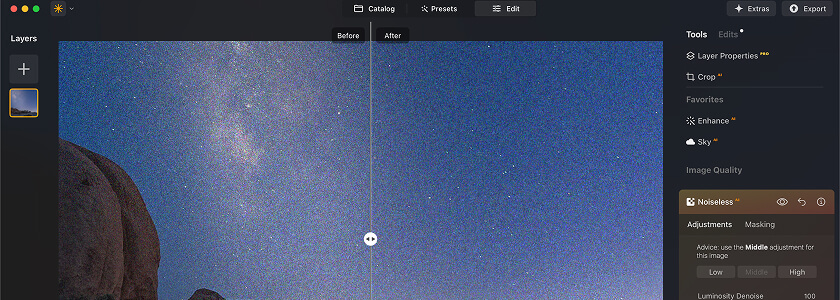
AI-Powered Features:Automation vs. Creative Control
AI is where things start to get spicy. Both programs are loaded with machine-learning tools that promise to do the heavy lifting, but they approach it very differently.
ON1's AI: Built Into the Workflow
ON1 Photo RAW brings its AI right into the heart of your workflow. You've got Brilliance AI for smart image enhancement, Super Select AI for dead-simple brushless masking and local adjustments, and NoNoise AI for top-tier noise reduction and deblurring. And, you can use them directly in the main editing flow without switching apps or waiting on clunky plugin handoffs.
Other notables:
- Resize AI (massive upscaling with print quality)
- Generative Erase & Crop AI (object removal and recomposing that doesn't look AI-fake, no round-tripping to other software required)
- Portrait AI (natural-looking skin smoothing, eye brightening, and face sculpting without going plastic)
- Tack Sharp AI (sharpening that doesn't overcook your images)
- Sky Swap AI (One-click sky replacement with realistic lighting and masking)
Because ON1's AI is fully integrated, you can layer, mask, or fine-tune results without feeling locked in.
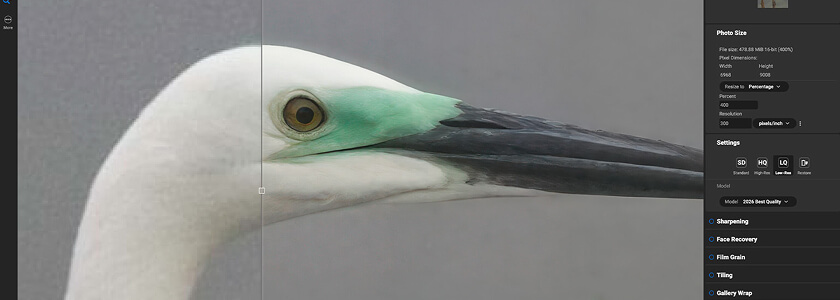
Luminar's AI: Fast, Flashy, and Focused on Style
Luminar Neo is all about creative AI flair. You get:
- Enhance AI (a single slider for instant punch)
- GenErase and GenSwap (removing or swapping objects with prompts)
- Supersharp AI (for focus correction)
- Portrait Bokeh AI (adding creamy background blur after the fact)
- Atmosphere AI (drop in fog for mood)
- Magic Light AI (boost light sources for that cinematic glow)
It's undeniably fun and fast for creating dramatic, share-ready edits. But... there's a catch. Many of Luminar's standout tools are either paid extensions or limited by annual access terms, even with a perpetual license. And while they do the job, you're often stuck with baked-in results. Want to tweak a specific mask or adjust one layer of your GenSwap composite? Good luck.
TL;DR:
- If you want integrated AI that speeds up a pro-grade workflow (masking, retouching, upscaling, cataloging), ON1 wins.
- If you're into playful, stylized edits with minimal effort, Luminar's creative AI tools scratch that itch, but expect to pay extra for the full arsenal.

Image Organization (DAM): A Professional Library vs. a Basic Browser
If you're editing more than a handful of photos a week, Digital Asset Management (DAM) is pretty essential. And in the ON1 vs. Luminar Neo conversation, this is where the split gets wide.
ON1: Professional-Grade Image Management
ON1 Photo RAW gives you a full-blown image management system that rivals (and in some ways improves on) Lightroom. You get:
- Optional catalogs (no forced import)
- Folder-based browsing
- Keywords, star ratings, color labels, and metadata editing
- Smart albums and search filters for power users
- Full non-destructive workflow baked into every organizational tool
You can manage a multi-terabyte photo library, cull quickly, apply filters across sets, and keep everything clean and searchable without babysitting a database or jumping through hoops.

Luminar Neo: Minimalist Browser for Casual Use
Skylum's Luminar Neo, on the other hand, gives you... a file browser. You can open folders and view images, sure. But there's no keyword tagging, no cataloging, no color ratings, and no real search functionality. If you're editing one-off images or just doing single-session projects, that's all you need. But good luck trying to work through a wedding, a portrait batch, or your 200GB vacation archive.
TL;DR:
- ON1 is made for scalable, organized editing workflows.
- Luminar is built for quick, shoot-and-go edits (and it shows).
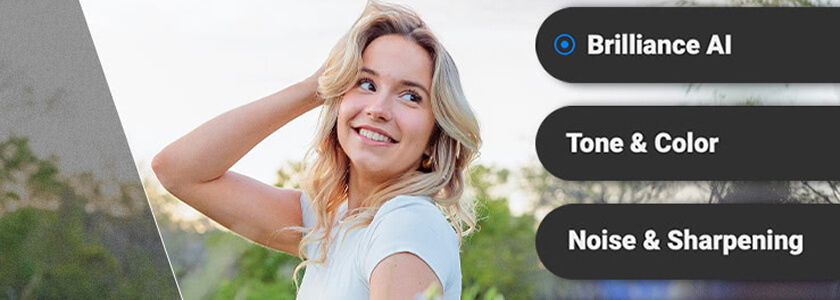
RAW Processing & Image Quality: Granular Control vs. Stylized Output
When it comes to RAW processing, ON1 and Luminar aren't playing the same game. And if you care about fine-tuned image quality, this is one of the most important differences.
ON1 Photo RAW: Precise, Flexible RAW Control
ON1 Photo RAW is built for control freaks (in the best way possible). Its RAW engine is optimized for detail retention, dynamic range, and accurate color reproduction. You can dig deep into tone curves, HSL adjustments, LUTs, and precision color grading without feeling like the software is fighting you.
It also supports nearly every major camera profile and RAW format, making it a reliable choice whether you're shooting on a Canon DSLR, Sony mirrorless, or medium-format Fuji.

Skylum Luminar Neo: Speed and Style (Sometimes at a Cost)
Skylum's Luminar Neo takes a more stylized, auto-driven approach. When you load a RAW file, Neo often applies a baked-in look right away, which can make your images "pop" fast, but it also means less granular control over the tonal range and sharpness. Want to fine-tune shadow contrast without touching midtones? Adjust individual color channels? You'll quickly find Neo's toolset more limiting than ON1's.
TL;DR:
- ON1 is the pick if you want precise, pro-level control over your RAW files.
- Luminar is fine if you're okay with stylized, one-click edits that do most of the thinking for you.

Layers & Masking: Photoshop-Style vs. Limited Stacking
This is where ON1 vs. Luminar Neo stops being a friendly comparison and turns into a clear mismatch.
ON1: Photoshop-Level Power
ON1 Photo RAW gives you true Photoshop-style layers. You can stack multiple images, blend modes, and adjustment layers; build composite edits; and create non-destructive, multi-layer workflows.
Pair that with AI-powered masking tools like Super Select AI and Mask AI, and suddenly complex selections—like isolating a subject from a chaotic background—feel almost effortless. It's all fully integrated, meaning you don't need to bounce between apps to get that "Photoshop-level" control.
Luminar: Keeps Things Lightweight
Luminar Neo, by contrast, offers effect stacking, which sounds similar but isn't. You can apply adjustments on top of each other, but there are no true layers, no blending modes, and no grouped adjustments. Masking exists, but it's basic compared to ON1's precision tools, making Neo less suited for detailed compositing or advanced retouching.
TL;DR:
- ON1 gives you layer-based freedom for creative projects and complex edits.
- Luminar's effect stacking is fine for simple tweaks, but that's where it stops.
Performance & Speed: Who Runs Faster?
Editing software can have all the bells and whistles in the world, but if it crawls when you're batch-exporting or previewing AI effects, you're going to hate using it. So, how do ON1 vs. Luminar Neo stack up when it comes to pure speed?
ON1 Wins for Speed and Consistent Performance
ON1 Photo RAW is designed to stay snappy, even on mid-spec machines. Fast culling tools make it easy to whip through large shoots, AI previews render quickly so you aren't left staring at spinning wheels, and batch exporting multiple file types runs efficiently (think high-res TIFFs + small JPEGs for clients).
The software feels purpose-built for high-volume workflows, whether you're editing hundreds of wedding shots or cranking out a commercial set.

Luminar Runs Smoothly for Light Edits
Luminar Neo, to its credit, has made big strides with its modular engine, which lets you load AI tools like GenErase or Supersharp AI as needed. But load up a large catalog or try running multiple AI adjustments on a batch of RAWs, and you'll feel the lag. It's clear Neo was built with casual, one-off edits in mind, not enterprise-level photo management.
TL;DR:
- ON1 keeps up with demanding, high-volume editing sessions.
- Luminar works well for lighter, single-image projects but doesn't scale as gracefully.
Pricing & Value: True Cost Over Time
Let's talk money. If you're weighing Luminar Neo vs. ON1 Photo RAW, pricing is one of the most important, and often most misunderstood, factors. Both brands claim to offer "no subscription required," but the real-world value shakes out very differently.
ON1 Photo RAW Pricing Breakdown:
- Photo RAW (Core App): $99.99 (often on sale for ~$69.99)
- Photo RAW MAX: $199.99 (includes full plugin suite + mobile app + cloud sync — often discounted to ~$99.99)
- ON1 Everything Plan: $7.99/mo or $50/year (2 devices, core app, mobile, plugins, 200GB cloud)
- ON1 Everything Plus: $17.99/mo or $140/year (5 devices, 1TB cloud, ON1 Plus membership with training + community access)
No upsells. No surprise "extension packs." You get the whole suite upfront or on a low-cost plan.
Skylum Luminar Neo Pricing Breakdown:
- Perpetual Desktop License: $417 (currently $119 on sale)
- Cross-Device License: $477 (currently $159 on sale)
- Max License: $546 (currently $179 on sale — includes 1 year of AI tools + Creative Library access)
- Extensions like Supersharp AI, HDR Merge, Upscale AI, etc., are either bundled or require separate purchase, depending on your tier.
- Ongoing access to key AI tools requires renewal after 1 year, even with "lifetime" licenses.
To unlock the full feature set, you're either paying steep up-front pricing or recurring costs through add-ons and renewals.
The Real Cost Over 2-3 Years
ON1's pricing remains consistent and affordable, especially with the MAX bundle or Everything Plan. You get full functionality without having to think twice. Luminar's model feels like buying the base car and then paying extra for the engine, tires, and steering wheel.
TL;DR:
- ON1 provides a complete, professional suite upfront. Its pricing is transparent and all-inclusive.
- Luminar's extensions model adds up fast if you want a fully loaded editing suite.

Who Is It For? Matching the Software to the User
By now, you've seen that ON1 vs. Luminar Neo isn't just a feature checklist; it's a difference in philosophy. So, who should actually pick which?
Go with ON1 Photo RAW if:
- You want an all-in-one Lightroom + Photoshop alternative with no subscription strings attached.
- You need serious library management (keywords, smart albums, catalogs) for large photo collections.
- Your workflow includes batch editing, multi-layer composites, or advanced masking.
- You'd rather pay once (or choose a low-cost subscription) and get everything you need upfront.
Choose Luminar Neo if:
- You prefer fast, one-click edits and don't need deep manual control.
- You mostly edit one-off images or small projects without cataloging.
- You love creative AI effects like sky swaps, atmosphere overlays, and dramatic style filters—even if that means paying for extensions.
Luminar Neo is the fun, fast filter machine. ON1 Photo RAW is the full creative studio.
Why ON1 Photo RAW is the Clear Choice
So, after putting ON1 vs. Luminar Neo head-to-head, what's the verdict?
Both programs deliver on their promises: Skylum's Luminar Neo makes it ridiculously easy to create bold, Instagram-ready edits in seconds, while ON1 Photo RAW gives you a full creative control center for serious editing and management.
But if you want a true Lightroom + Photoshop replacement that combines RAW processing, cataloging, AI tools, layer-based editing, and pro-level output, all without the subscription handcuffs or hidden upsells, ON1 Photo RAW pulls ahead. It's the software built for photographers who want speed and depth in one package.
If you're ready to see the difference, don't just take our word for it. Try ON1 Photo RAW free today and see why more photographers are switching for good.
Frequently Asked Questions: ON1 vs. Luminar Neo
Is ON1 Photo RAW better than Luminar Neo for beginners?
If you're just starting out, Luminar Neo feels simpler thanks to its one-click AI presets and creative filters. ON1 Photo RAW has a steeper learning curve, but it rewards you with more control and flexibility as your editing skills grow.
Does Luminar Neo offer more creative effects than ON1?
In terms of playful, dramatic edits like sky swaps, atmosphere overlays, and artistic presets, Luminar Neo leans more into creative effects. ON1 also offers sky replacement and filters, but its focus is more on precision tools and professional workflows.
Can ON1 Photo RAW replace both Lightroom and Photoshop?
Yes. ON1 Photo RAW combines a Lightroom-style catalog with Photoshop-style layers and masking, making it a true all-in-one solution. Luminar Neo offers strong editing tools but lacks the advanced layering and cataloging needed to fully replace Adobe.



